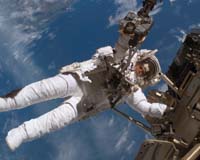 |
Washington (AFP) April 13, 2010 US astronauts on Tuesday completed the third and last space walk of their mission to the International Space Station (ISS), NASA said. The outing kept mission specialists Rick Mastracchio and Clayton Anderson outside the ISS for six hours and 24 minutes, and was the sixth space walk for both astronauts. During the space walk, the two astronauts finished installing a new ammonia tank for the ISS's cooling systems, relocated a portable foot restraint, and prepared cables on a truss for a space-to-ground Ku-band antenna. The latter two chores had to be completed ahead of space shuttle Atlantis' mission to the ISS next month. The space walk took longer than originally scheduled because the astronauts had problems stowing the depleted ammonia tank assembly on a carrier in the shuttle's cargo bay. The empty tank will be brought back to Earth. After wrapping up the space walk, the shuttle and ISS crews continued to unload the Leonardo Multi-Purpose Logistics Module and transfer 17,000 pounds (7,711 kilograms) of science racks and other supplies from the shuttle into the station. This is the final roundtrip to the station for the 21-foot-long, 15-foot-diameter (6.4 x 4.5 meters) Leonardo. Once back on Earth, the module will be reconfigured with increased shielding on the outside for a shuttle mission in September, when Leonardo will be left on the station as a permanent module. The shuttle mission is the fourth from last before the shuttles are retired, and the space walk was the 115th based out of the ISS, which is nearly completed -- 12 years after the first part of the orbiting space station was launched in 1998. Discovery is due to return to Earth on Monday after a 14-day mission in space, or a day longer than initially planned. The extra day in space was added after the Ku-band antenna on board the shuttle stopped working on the first day of the mission. Ku-band communications systems are used to transmit data -- including scans and videos of the shuttle's heat shield -- from space to mission control. Since space shuttle Columbia broke up on re-entry into the Earth's atmosphere in February 2003, NASA has meticulously inspected the heat shield on the shuttle fleet before re-entry to make sure the protective panels have not been damaged by space debris or small meteorites. The inspection usually happens after the shuttle has undocked from the ISS. But because the shuttle's Ku-Band communications system was not working, the Ku system on the ISS transmitted the heat shield video and laser scan to mission control for experts to analyze. The shuttle's heat shield is subjected to temperatures as high as 1,500 degrees Celsius (2,732 Fahrenheit) due to friction on reentry.
Share This Article With Planet Earth
Related Links Station at NASA Station and More at Roscosmos S.P. Korolev RSC Energia Watch NASA TV via Space.TV Space Station News at Space-Travel.Com
 ISS Building Crews Hard At Work During STS-131
ISS Building Crews Hard At Work During STS-131Houston TX (SPX) Apr 13, 2010 Mission Specialists Rick Mastracchio and Clayton Anderson configured their tools in the Quest airlock. After a review of spacewalk procedures with other crew members, they are again spending the night in the airlock, its pressure reduced to 10.2 psi. That campout is aimed at reducing the nitrogen in their blood to avoid decompression sickness. The third and final STS-131 spacewalk is sched ... read more |
|
| The content herein, unless otherwise known to be public domain, are Copyright 1995-2010 - SpaceDaily. AFP and UPI Wire Stories are copyright Agence France-Presse and United Press International. ESA Portal Reports are copyright European Space Agency. All NASA sourced material is public domain. Additional copyrights may apply in whole or part to other bona fide parties. Advertising does not imply endorsement,agreement or approval of any opinions, statements or information provided by SpaceDaily on any Web page published or hosted by SpaceDaily. Privacy Statement |